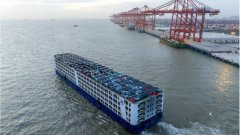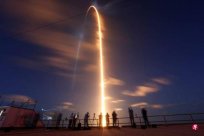
Recently, the fourth test flight of the American Space Exploration Technology Corporation (SpaceX) completed the fourth test flight of the "Star Ship" of the ultra -heavy carrier rocket.As the booster smoothly splashed in the designated waters, the spacecraft achieved controlled and then entered the atmosphere. The test flight reached the expected goal and achieved a major breakthrough.According to design indicators, the "Star Ship" is the most comprehensive carrier rocket in human history.
In addition to the "Star Ship", another major competitive advantage of SpaceX is that it can use mature large thrusts such as Falcon 9 and Heavy Falcon to recycle the carrier rocket, and high -frequency launch commercial load.In 2023, SpaceX performed 98 space launch tasks, while China only implemented 67 times.In terms of orbit quality, the gap is more obvious: SpaceX has been sent to the scheduled track of 1195 tons, accounting for 80%of the world's.In addition, the launch cost of the Falcon series of carrier rockets does not exceed $ 3,000 per kilogram, which is far lower than the average level of 10,000 to 20,000 US dollars per kilogram of the global commercial space market.
For SpaceX, Chinese officials have actually gained a low posture.At the end of 2023, China Aerospace Science and Technology Group announced that compared with SpaceX, it was "big but not strong, big but not excellent", which is far from the target of the construction of the aerospace power.The development of Chinese aerospace is led by the country.As the largest aerospace state -owned enterprise, China Aerospace Technology Group is almost synonymous with China Aerospace, which is equivalent to recognizing the strength gap between Chinese aerospace and SpaceX.Since the beginning of this year, CCTV News and other official media have also quoted SpaceX cases to demonstrate the necessity of developing commercial aerospace in China.
However, for such a commercial aerospace giants that have risen strongly in a specific geographical political background and may even affect international political and economic order, it seems that it is not enough to emphasize that "humbly learning" is not enough.China needs to have a more comprehensive and objective understanding of SpaceX and make adjustments in strategic thinking.
First of all, the conclusion of "big but not strong" itself needs to be questioned.It is true that SpaceX is very good at the development of carrier rockets, but aerospace is a huge system engineering, and the carrier rocket is just one of them.It is undoubtedly one -sided to evaluate the comprehensive strength from a single aspect.
For example, the Chang'e -6 detector that completes the sampling of the moon back and the Tianwen No. 1 detector that realizes Mars' landing does not exceed 8.2 tons.The capacity has reached 9 tons.If the carrier rocket is the only decisive factor in the success or failure of the aerospace mission, China can collect samples from the back of the moon as early as the 1990s, and even land on Mars.Obviously, this is not the case.In addition to the Rockets itself, similar detection tasks are inseparable from the support of navigation equipment, deep space communication networks, high -precision radar, energy supply device, spacecraft gesture control system, variable thrust engine, obstacle avoidance algorithm and other core technologies.Do SpaceX master all these core technologies?The fact is that the SpaceX, who is the ultimate dream, has not yet flew out of the ground, and China has achieved surround, landing and inspecting the moon and Mars.
Even on the near -ground track, SpaceX is not a comprehensive leader. At least it cannot be built and operates an third -generation space station independently like China.Of course, SpaceX has the world's largest low -track high -speed Internet satellite constellation "Star Chain", but China also has the world's largest satellite navigation system.
SpaceX is stronger than Chinese aerospace, a controversial question.Only compared with the entire American aerospace can we say that Chinese aerospace is "big but not strong". After all, Chinese aerospace is also a complete industrial system.
What is more important is that in the context of the intensified competition between China and the United States, what is SpaceX's practical significance for China?Or what does it mean to China?
In essence, SpaceX is still the spokesperson for the interests of the United States, at least a passive spokesperson, which determines that the development of SpaceX is difficult to bring well in China.From the report of the Cowker to the Wolf Amendment, Washington officials have spared no effort to curb the latter development by restricting Chinese aerospace participation in international cooperation.Although the Wolf Amendment only prohibits the US government agencies such as the US Aerospace (NASA) conduct space cooperation with China and does not cover private companies such as SpaceX, because Washington officials have also set up other policy barriers, such as international weapons trade regulations,The export management regulations and the foreign investment review committee, the effective cooperation between SpaceX and China is still difficult to achieve, because it will be strictly reviewed by various aerospace products, services or technologies output in China.Out of US national security concerns, the probability of related transactions cannot be achieved.
Even so, if SpaceX's business does not exceed the business category, it will not have negative consequences.However, since the Russian and Ukraine War, the "Star Chain" has transmitted a lot of information information to the Ukraine and improved its blow accuracy of the Russian army.Given that the United States has listed China as the largest strategic opponent, the "Star Chain" may also become a military tool for China.What's more, as early as the end of 2021, the "Star Chain" satellite was exposed to the high speed close to the China Space Station not only before not only before the notice, which pose a threat to the life and health of the station in the station.These satellites carry out unknown continuous orbit, forcing the space station to take emergency anti -collision measures, and the United States has not explained the abnormal behaviors of these satellites so far.
Although China is open to international aerospace cooperation, Washington's official long -arm jurisdiction can easily destroy related cooperation prospects, not to mention that SpaceX has begun to serve the United States' intervention in regional situations, and even threatened China's national security.Essence
In short, China should adhere to the attitude of "paid attention to tactical attention and strategic contempt".The Chinese aerospace department must objectively evaluate the strength of SpaceX to avoid underestimation or overestimation, to obtain more accurate self -positioning, and at the same time clarify the strategic focus, use the entire American aerospace industry as the primary reference object and catch -up goals to avoid being disturbed by a separate SpaceX.layout.In the current geopolitical environment, China should recognize the essence and limitations of SpaceX, as well as the zero -harmony relationship between the two parties.Of course, China needs to learn SpaceX's innovation and commercialization strategy, but the ultimate goal is to compete and consolidate its advantages to more effectively safeguard national security and development benefits.
The author is a doctoral student at the School of Political and International Relations of Lanzhou University




